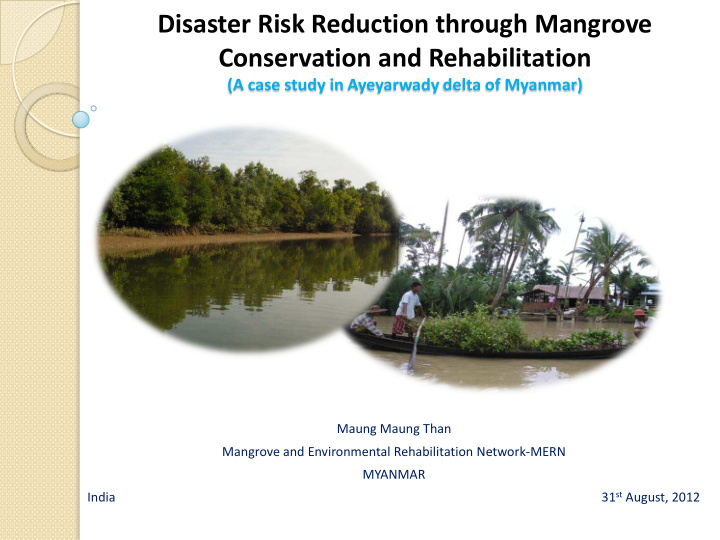



Disaster Risk Reduction through Mangrove Conservation and Rehabilitation (A case study in Ayeyarwady delta of Myanmar) Maung Maung Than Mangrove and Environmental Rehabilitation Network-MERN MYANMAR 31 st August, 2012 India
Mangrove areas in Myanmar 101 92 o o E E 29 o N India China Myanmar Thailand Total area: 271607 ha Total area: 165788 ha Mangrove areas 100 km 10 o N Rakhine State Ayeyarwady delta Tanintharyi Region Total area: 259028 ha Grand total: 696,423 ha
Deforestation of mangroves in Ayeyarwady detla 1975 2001 2008 1990
Devastation of Cyclone Nargis in May 2008 According to Post Nargis Joint Assessment –PONJA report, some 17,000 hectare of natural forest and 21,000 ha of forest plantations were damaged, with an estimated cost of Kyat 14 billion ( About 14 million USD).
Formation of Mangrove and Environmental Rehabilitation Network-MERN The idea of Networking among the local environmental NGOs was initiated since December, 2008. And, MERN officially formed on 1 st August 2009.
Rationale Review of achievements, opportunities, challenges and lesson learned of mangrove conservation and reforestation for Disaster Risk Reduction through small grant projects and Joint project are needed to know whether policy targets are met. Objective To share lesson learned gained from small grant projects to relevant stakeholders involving in mangrove conservation and reforestation
Activities of Small Grant projects
Activities of small grant projects
Activities of Joint projects
Achievements of projects - 41 village comprising of 6460 households - Community Base Organizations-CBOs were formed and trained - Project staff were trained to strengthen capacity - 160 ha of mangrove plantation established, with above 80% in survival - 800 villagers were trained for mangrove reforestation and conservation - Livelihood supports were provided (Ducks, Fishes, cash crop etc.) - Distribution of 600 efficient stoves
Achievements of MERN network • Policy advocacy for revision of Community Forestry Instructions and Forest Law • Networking with international organizations such as IUCN, MFF, Wetland International, UNDP, FAO, JICA etc., • Capacity Building for member organizations and Media . Evident Base Research
Opportunities and Challenges Opportunities Challenges Well Understanding on • Improper land use value of mangroves planning Support from local and • Poverty international • Lack of alternative organizations energy Possibility of recovery of • Inadequate fund mangrove ecosystem Interest of government
Lesson learnt from the projects Organizational Development and Capacity Building of CBOs are decisive. Policy advocacy and engagement should be addressed to overcome policy failure Improvement of livelihood for mangrove dwellers is a must. How to sustain the outputs of small grant and joint projects, especially for the mangrove management.
Conclusion Outputs of Small grant and Joint projects were achieved Policy advocacy of MERN was to some extent successful Lack of proper land use planning, poverty of community and shortage of capacity were main obstacles Mangrove conservation and reforestation is still needed for disaster risk reduction and livelihood improvement of local communities.
Recommendations • To extend policy advocacy to line departments as well as local governments • To initiate Public-Private partnership to assist poverty reduction • To speed up capacity building and strengthening • To formulate a proper strategies for mangrove conservation and reforestation
Thanks for your attention!
Recommend
More recommend